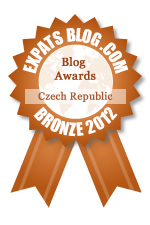By Ricky, on July 7th, 2014
The ‘Winged Lion’ monument © Ricky Yates
As I mentioned at the beginning of my previous post, I had a most interesting week in advance of my laptop computer lock-out problems. The highlight was attending two interrelated events on the afternoon and early evening of Tuesday 17th June.
The first event was the official unveiling of this monument, entitled ‘The Winged Lion’, by Sir Nicholas Soames MP, grandson of Sir Winston Churchill. It commemorates the nearly two and a half thousand Czechs and Slovaks who escaped from Czechoslovakia after the country was occupied by the Nazis in 1939, and served in the Royal Air Force during the Second World War.
As this BBC news article explains, the idea for the memorial . . . → Read More: Celebrating brave Czechoslovak Airmen and the Official Birthday of Her Majesty the Queen
By Ricky, on August 24th, 2013
Memorial to the victims of the Soviet invasion of August 1968 © Ricky Yates
This past week saw the forty-fifth anniversary of the invasion of Czechoslovakia by the Soviet Red Army, which brought to an abrupt end, the short period of liberalisation known as the ‘Prague Spring’. On the night of 20th – 21st August 1968, around 200,000 Soviet troops poured over the borders from surrounding Warsaw Pact countries, supported by airborne troops, equipped with artillery and light tanks, who were flown in via Prague Airport. Along with the Soviet forces, there were also contingents of troops from Poland, Hungary, Bulgaria and East Germany.
Whilst Alexander Dubcek, the Czechoslovak leader who had sought to introduce, ‘socialism with a human face’, called on his people not to resist, many ignored his advice and over one hundred citizens were killed and many more injured. This memorial . . . → Read More: The Soviet invasion of 1968 and its aftermath
By Ricky, on November 5th, 2012
Liberec Town Hall © Ricky Yates
The city of Liberec is situated 110 km north-east of Prague, quite close to the border of the Czech Republic with both Germany and Poland. Known in German as Reichenberg, it lies within the former Sudetenland and had a majority German-speaking population until the vast majority were expelled in 1945-6, at the end of the Second World War.
We paid our first visit to Liberec on my day-off four weeks ago, Monday 8th October. The chief reason for our trip was to visit Liberec Zoo, which is home to a pair of rare White Bengal Tigers, who earlier this year, successfully produced three tiger cubs.
Liberec Zoo is located in a leafy suburb east of the city centre. It has the distinction of being the oldest zoo in the Czech Republic, having been founded in 1919, well . . . → Read More: Liberec
By Ricky, on May 8th, 2012
Statue of Soviet Marshall Ivan Konev with floral tributes © Ricky Yates
Inscription alongside the statue © Ricky Yates
Today is a public holiday here in the Czech Republic, as it is in several other European countries. The public holiday marks the ending of World War Two, sixty-seven years ago, on 8th May 1945.
I took the photograph on the left today. It is of a statue that stands in Námestí Interbrigády, a large square on one side of Jugoslávských partyzánu, the main thoroughfare leading from our nearest Metro station at Dejvická, to Podbaba where we live. And the person it portrays is Marshall Ivan Stepanovich Konev of the Soviet Red Army, who led the troops that liberated Prague from Nazi occupation, finally entering the city early on 9th May 1945, just a few hours after the unconditional surrender of all Nazi troops . . . → Read More: Liberation Day – 8th May 2012
By Ricky, on November 11th, 2010
Besídka Restaurant & Hotel, Slavonice © Ricky Yates
Less than 30 km south of Telc lies the little town of Slavonice. On the morning of Thursday 7th October, we drove from Telc to Slavonice, stopping off to briefly explore the intervening town of Decice en-route.
Slavonice has some of the best examples of buildings with sgraffito decoration in the whole of the Czech Republic. The reason that so many of these architectural gems have survived is because of the town’s somewhat unfortunate history. A prosperous town in the latter part of the sixteenth century from which period, many of the town’s historic buildings date, it lost much of its prosperity during the Thirty Years War (1618-1648) and suffered a further economic downturn when the main road between Prague and Vienna was re-routed in the eighteenth century.
In the twentieth century, two further events . . . → Read More: Slavonice
|
rickyyates.com is a participant in the Amazon Services LLC Associates Program, an affiliate advertising program designed to provide a means for sites to earn advertising fees by advertising and linking to Amazon.
|



Recent Comments